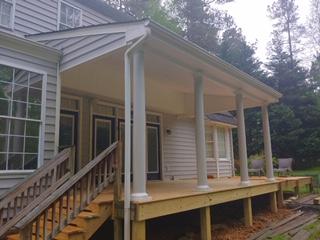Adding a Roof Over an Existing Deck
Often when we build a deck on a house, it only takes a little time in the heat of the summer sun, and we quickly realize it would be nice to have some shade when enjoying the outdoors.  How hard is it to install that roof over your deck to achieve that oft needed shade? It really depends. If you have a single-story dwelling, then adding a roof may mean you have to build a gable (A-frame) roof and then tie that into your existing roof. That can be a little complex for your Do-It-Yourself project. If you have a 2-story home and you are simply adding the roof to the side of your home, as in our recent project shown here, then this may fall under the category of “doable” for you depending on your carpentry skills. This week I will walk through the steps of building that easier of the two-deck roof pointing out tips that will help to make it as easy as possible.
How hard is it to install that roof over your deck to achieve that oft needed shade? It really depends. If you have a single-story dwelling, then adding a roof may mean you have to build a gable (A-frame) roof and then tie that into your existing roof. That can be a little complex for your Do-It-Yourself project. If you have a 2-story home and you are simply adding the roof to the side of your home, as in our recent project shown here, then this may fall under the category of “doable” for you depending on your carpentry skills. This week I will walk through the steps of building that easier of the two-deck roof pointing out tips that will help to make it as easy as possible.
1.) Check with your local building department and apply for any permits you will need. Typically, you will need a building permit and at least a readable sketch of what your addition will look like. You will have to fill out a few forms detailing what size lumber you intend to use and center spacing. Most building departments will help you with answering those questions as you apply for the permits. Once you have the permits and have worked up a material list go ahead and get your material.
2.) Setting your ledger board. The ledger board is the point at which you will attach your rafters. It will attach directly to the side of your house. You will need to clear space for it by removing the siding. Note where the studs are and mark their locations. You will use those studs as anchor points to secure your ledger board. The ledger board needs to be secured properly in order to support the rafters that will be attached to it. You can’t depend on nails to hold it securely so use either 4” lag screws or I like to use Ledger Loks. This is a newer product that is engineered just for this purpose. Most municipal building departments will accept them instead of lag screws or carriage bolt and for me they are well worth the little extra expense in the time they save on the job. If you put 2 Ledger Loks per wall stud and you can rest easy at night knowing that that ledger will hold any snow load put on it here in central Virginia.
3.) Building the support beam. There are 2 areas that need extra attention because of the weight they will have to support in building your roof. The ledger board attached to your house that supports one end of your roof rafters is the first. The support beam that supports the other end of your rafters is the other. The size of lumber you will need for your beam will depend on the distance it is from the ledger wall. The greater the distance of the span, the bigger the rafter size will need to be and the heavier the beam will need to be. In the job pictured, I was spanning 12 feet and so used 2×8 rafters. The support beam out front was constructed of 3- 2×10’s. The overall length of the beam was 20 feet. A beam that big when completed is pretty heavy and needs good supports. In this case we used four 8” fiberglass composite columns. Each column is rated at 10 tons which may seem like overkill, but considering the weight of the roof and the potential for the occasional heavy wet snow it really is about right. Optimally, one would like to build this beam on the ground and then lift by machine into position. You can build it in place a piece at a time (like I did) even by yourself (like I did) if circumstances warrant. I built temporary supports (3 of them) and then installed the side boards going from the house to be attached to the beam, and then built the beam one or two boards at a time (depending on the weight and how early in the day it was). As I put up each board of the nine, I would end up using, I would attach it to the end board or the previously installed board. When it was all in place, I then used 4 ½” Header Loks to pulled it all together tightly. (Tip: once it is up and tied together it won’t necessarily be straight. You will need to stretch a string down it’s length and then use boards to push and pull it into a straight line. This will help with the next step.)
4.) Setting the rafters. To get the rafters to set flat on your beam and the birdsmouth to fit flush to the outside of the beam you will need to know your roof pitch. I will take a little extra time working out the exact pitch where the rafter hits my ledger board. Once I have that I will tack it up temporarily and then holding it on the beam end, scribe the exact size and shape of the birdsmouth. Once I have that right I use that board as the pattern and make all succeeding rafters the same. (Tip: It is very important that before you start setting rafters, make sure your beam is square to the house.) The rafter end attached to the wall ledger board will need additional support, so use an engineered rafter hanger. This will also make the building inspector happy especially if you fill every hole in the strap with a nail. You should also on the beam side tie down your rafters with an approved “hurricane” clip.
5.) Attach sub-fascia. (Tip: Use a string to mark all the rafter tails at the desired length.) I usually measure out about 10 ½” so that when complete I have about a 1-foot overhang. Using a stretched string to mark your rafter tails will give you a nice straight line. Then cut them and nail on your sub-fascia. Your ready now for decking.
6.) Decking your roof. Most decking is done with 7/16” OSB. Use galvanized 6 or 8 penny nails and remember to nail a consistent pattern of at least 5 nails in the centers and on the edges double that. Remember to stagger your joints so that no adjacent succeeding row of OSB ends up on the same rafter previously used for a joint.
7.) Roof felt and Shingles. Before you put felt or another approved barrier down, make sure and install weather guard barrier to the outer 3 feet of the roof (front edge and both sides). This will prevent water seepage back up under shingles from ice and snow build up on a roof. Follow installation instructions on felt and shingles.
8.) Framing in the gable sides. On the sides from the side boards to the edge of the last rafter, you will need to frame in that area and cover it with 7/16” OSB. Just put your 2×4’s on edge and space them every 2 feet. Cover with OSB and then an approved house wrap. That house wrap is a moisture barrier that you will need for your “veneer” inspection. It won’t pass inspection without it.
9.)Call for your framing and veneer inspections: At this stage call for your inspections. Building inspectors will look for many of the things already mentioned in the above: Proper lumber size, proper spacing between rafters, rafter hangers, hurricane clips, proper ledger fasteners, and house wrap for the veneer.
10.) Finishing touches; Once inspections pass, put on your siding on the gable ends. Put on your fascia board and soffit. The last thing to do it to wrap you beam with trim coil and install a ceiling. I will describe those steps in the next post.
The links to external sites in this post are affiliate links, and we will be compensated when you make a purchase by clicking through our links.


Hello. Do you have an example Materials List that goes along with this project? I found this very informative as we are planning to add a roof over an existing deck. What materials and how much were ordered/utilized, and how much did the completed project cost? Thank you for the information.
Hello and thanks for your question about this project! James will review and provide the information you requested as soon as possible. Thanks for visiting the DCI blog!